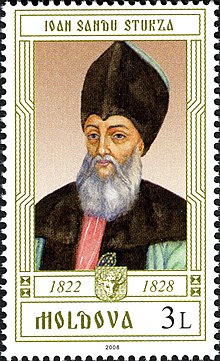Ioan Sturdza: Difference between revisions
RedPlanetoid (talk | contribs) m typography |
m add authority control |
||
| Line 31: | Line 31: | ||
==Biography== |
==Biography== |
||
{{ |
{{unreferenced section|date=June 2015}} |
||
Sturdza is considered the first indigenous ruler with the end of [[Phanariote]] rule (as a move the [[Ottoman Empire]] undertook after seeing the political disadvantages of [[Greeks|Greek]] domination after the troubles in the [[Greek War of Independence]]). |
Sturdza is considered the first indigenous ruler with the end of [[Phanariote]] rule (as a move the [[Ottoman Empire]] undertook after seeing the political disadvantages of [[Greeks|Greek]] domination after the troubles in the [[Greek War of Independence]]). |
||
Immediately after the Greek revolution, Prince Ioan Sturdza took an active part in subduing the roving bands of [[Filiki Eteria|Eterist]]s in [[Moldavia]]; he transformed the [[Greek language]] elementary schools into [[Romanian language]] ones and laid the foundation for that scientific national development which Prince [[Mihai Sturdza]] continued after 1834, especially after his founding of an upper school in the [[Trei Ierarhi Cathedral]] complex in [[Iași]]. Although his project for the confiscation of some Church properties was initially blocked by Russia, Sturdza opted not to revise his position. |
Immediately after the Greek revolution, Prince Ioan Sturdza took an active part in subduing the roving bands of [[Filiki Eteria|Eterist]]s in [[Moldavia]]; he transformed the [[Greek language]] elementary schools into [[Romanian language]] ones and laid the foundation for that scientific national development which Prince [[Mihai Sturdza]] continued after 1834, especially after his founding of an upper school in the [[Trei Ierarhi Cathedral]] complex in [[Iași]]. Although his project for the confiscation of some Church properties was initially blocked by Russia, Sturdza opted not to revise his position. |
||
| Line 42: | Line 42: | ||
==Notes== |
==Notes== |
||
{{ |
{{More citations needed|date=March 2012}} |
||
{{reflist}} |
{{reflist}} |
||
| Line 56: | Line 56: | ||
}} |
}} |
||
{{s-end}} |
{{s-end}} |
||
{{authority control}} |
|||
{{DEFAULTSORT:Sturdza, Ioan}} |
{{DEFAULTSORT:Sturdza, Ioan}} |
||
Revision as of 02:00, 13 April 2020
| Ioan Sturdza | |
|---|---|
 | |
| Prince of Moldavia | |
| Reign | 21 June 1822 – 5 May 1828 |
| Predecessor | Michael Soutzos |
| Successor | Mihail Sturdza |
| Born | 1762 Iași |
| Died | 2 February 1842 Paris |
| House | Sturdza family |
| Religion | Orthodox |
Ioan Sandu Sturdza or Ioniță Sandu Sturdza (1762 – 2 February 1842) was a Prince of Moldavia from 21 June 1822 to 5 May 1828.
Biography
Sturdza is considered the first indigenous ruler with the end of Phanariote rule (as a move the Ottoman Empire undertook after seeing the political disadvantages of Greek domination after the troubles in the Greek War of Independence).
Immediately after the Greek revolution, Prince Ioan Sturdza took an active part in subduing the roving bands of Eterists in Moldavia; he transformed the Greek language elementary schools into Romanian language ones and laid the foundation for that scientific national development which Prince Mihai Sturdza continued after 1834, especially after his founding of an upper school in the Trei Ierarhi Cathedral complex in Iași. Although his project for the confiscation of some Church properties was initially blocked by Russia, Sturdza opted not to revise his position.
Contested by the boyars who had taken refuge in Imperial Russia during Ypsilanti's military rule over the country, and threatened to lose his throne after the 1826 Russo-Turkish Akkerman Convention that established a seven-year term in office for Princes elected by the Divan (confirmed by the Ottomans, with Russia's approval), Sturdza agreed to many boyar demands, including tax cuts and exemptions from conscription. However, Sturdza ensured meritocratic criteria in access to public offices. At the same time, a conflict became apparent between high- and low-ranking boyars, after the proposed constitution of Ionică Tăutu was rejected by most of the former (a vocal minority under the leadership of Mihail Sturdza). In 1828, the Russians entered the country during the War and took Prince Ioan prisoner. He died while being kept in Bessarabia and was later buried in Iași.
See also
Notes
This article needs additional citations for verification. (March 2012) |
References
- This article incorporates text from a publication now in the public domain: Moses Gaster (1911). "Sturdza". In Chisholm, Hugh (ed.). Encyclopædia Britannica (11th ed.). Cambridge University Press.
